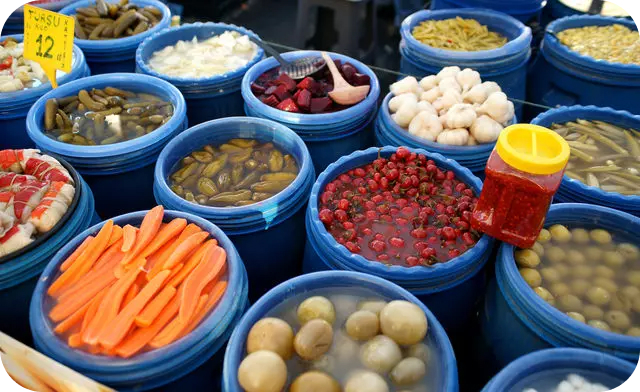
Storage tanks are used both in industries and households, not only in our country but also in various parts of the world. In industries, water storage products are commonly used for storing produced content, ensuring its preservation, facilitating transportation to customers, and serving various purposes.
Tanks employed for pickling and brining purposes are designed specifically to preserve pickled vegetables and fruits, allowing them to be stored after pickling, enabling transportation if needed, and ensuring the convenience of accessing pickles whenever desired. These tanks are tailored to serve specific purposes.
In these tanks designed for pickling and bringing, not only pickles but also olives, grape leaves, cheese, and similar food items can be brined. Due to the light sensitivity of the brining process, it is recommended to keep the stored contents in a dark area to preserve their quality.
What Are the Features of Pickle Tanks?
When considering purchasing a tank for pickling or bringing, it's logical to choose a tank that suits the specific task. Pickle tanks are produced using polyethylene material. They are manufactured in a monobloc form by pouring polyethylene into molds created for specific designs. As there are no additional attachments or rivets, these tanks are more durable and robust in structure.
Certain models of pickle tanks come with small lids, while others feature larger lids. Brine tanks, on the other hand, are produced in a uniform design and are available in various volume options. The fact that polyethylene is internationally recognized as safe for food contact makes it suitable for bringing purposes without any concerns.
Tanks made from polyethylene material are lighter in weight compared to others. The thickness of the tank's material increases proportionally with its volume. In terms of size variety, pickle tanks range from 500 liters to 10,000 liters. Generally, the design accommodates sizes ranging from 50 liters to 25,000 liters.
Given the diverse nature of pickles, major pickle producers often need to categorize their products. Consequently, all storage products can be manufactured in any desired color, allowing for easy categorization of different types of pickles.
After being emptied from the tank, sensitive foods like pickles should be cleaned to ensure there's no residue inside the tank, especially when transferring them into smaller packages. If storing delicate content like food, it's recommended to clean the tank after each use.
Another significant feature of pickle tanks is their resistance to ultraviolet rays. This characteristic prevents harmful rays from penetrating the tank. This is especially beneficial for light-sensitive contents like pickles and brined products, offering an ideal storage solution.
Can Pickle Tanks be Used at Home?
Tanks are not exclusive to large pickle manufacturers; they are also used in households. Pickle tanks are particularly popular in rural areas of our country. Regional farmers make pickles during the harvest season for consumption throughout the winter.
In this article, we've covered both the industrial storage of pickles and the individual, household storage aspect. If you're interested in purchasing these tanks to make delicious pickles, feel free to contact Karmod's customer representatives.


 EN
EN
 DE
DE
 FR
FR
 IT
IT
 ES
ES
 PT
PT
 RU
RU
 AR
AR
 BG
BG
 SR
SR
 GR
GR
 SQ
SQ
 RO
RO
 PL
PL
 HU
HU
 CZ
CZ
 HR
HR
 AZ
AZ
 GE
GE
 AM
AM
 IL
IL